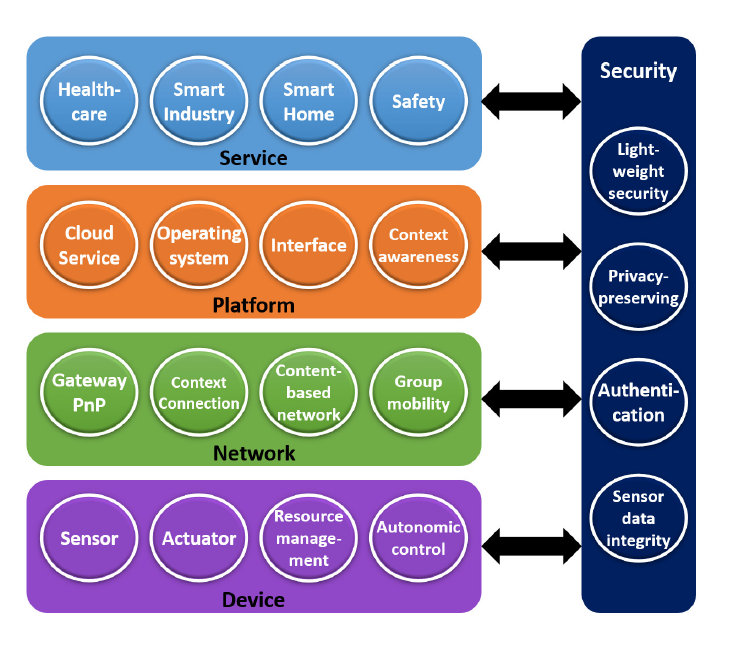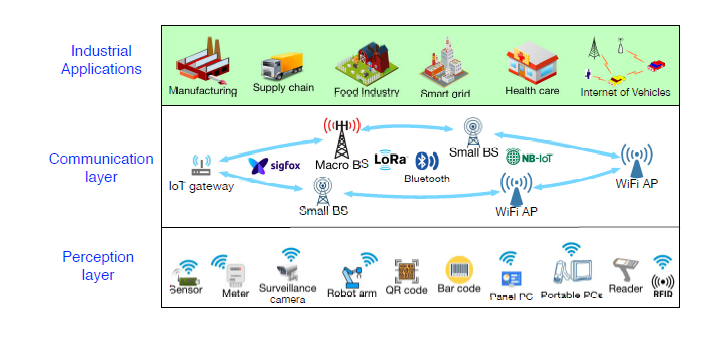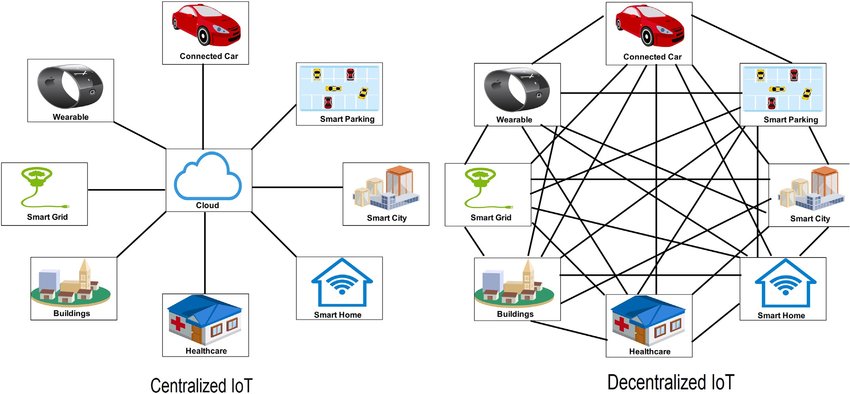Blockchain-based Sensor Data Validation
1. Introduction to Blockchain Technology and Sensor Data
This paper provides and overview of two technological fields: IoT
networks and Blockchain technology. These two fields are not necessarily
interconnected, but if combined they can bring certain advantages to
their respective field of application.
First, these two fields of interesed will be outlined separately in 1.1
and 1.2, whereas section 2. and 3. describe experimental setups to
investigate possible solutions for merging Blockchain technology with
IoT networks.
An overview of the Blockchain technology and its inherent mechanisms is
given, which can be used to validate data in different systems relying
on the exchange and processing of data. A collection of such systems is
listed here in order to point out which applications are suited for
having its data validated on the Blockchain.
There are certain areas for which Blockchain technology is discussed to
be used for data validation.
- Smart cities
- Supply chain for industrial manufacturing
- Electricity grids
- Banking, financial transactions
- Health care
- Science
Essentially, in all these areas a network of smart devices is formed, which is usually referred to as the internet of things (IoT). Basically, if security and sensitivity of exchanged data is an issue in a certain application network, it is appropriate to consider implementing Blockchain validation mechanisms for sensor data.
1.1 Basics of Blockchain Technology
The Blockchain can be described as an append-only database distributed among all members in a network. Due to several built-in mechanisms in the Blockchain's design, it allows the establishment of a network of non-trusting members unknown to each other, but still being able to interact directly. These inherent mechanisms are:
- Hashes: A hash is derived from a hash function which maps out an input to a random bit string.
- Private key encryption: Every member of a network is supplied with a public and a private key. The public key is like a bank account number or telephone number, publicly addressable. But a member's private key is kept secret by the member and will be used for encryption of transactions signed by him.
- Signed transactions: Every time a member emits a transaction on the Blockchain, the transaction will be signed by that member's private key ensuring that truly he/she has emitted that transaction. Additionally, a member who received a transaction from another member can verify that the sender of that transaction was truly the other member using the other member's public key.
- Consensus algorithm: An algorithm that dictates how new data (i.e. a new block) should be appended to the existing chain. Widely used algorithms are Proof of Work and Proof of Stake. When consensus is reached by a majority of members in the network the new block is appended to the chain.
- Mining: Spending computational effort in order to solve the puzzle to find a new hash for appending a new block to the chain. The successful miner, who found a suitable hash, will be rewarded with an amount of the Blockchains cryptocurrency (e.g. Bitcoin, Ether). Mining is most common in Blockchains using the Proof of Work consensus algorithm, where appending a new block requires high computational power.
- Smart contracts: A smart contract is a computerized transaction protocol that executes the terms of a contract. Some Blockchains (e.g. Ethereum) allow to deploy smart contracts to the chain. The smart contract needs to be developed in a suitable programming language, tested and deployed. After it is deployed, it's code cannot be altered anymore (which is an inherent mechanism of the Blockchain technology). For Ethereum the most widely used language for developing smart contracts is Solidity.
1.2 Basics of Sensor Data in Networks
Data from sensors is widely generated and processed in all kinds of networks. Through sensor data from smart devices, the physical world can be digitized and streamed with other data. A vivid example can be autonomous driving, where sensor data are collected and processed in real-time to feedback to control the movement of the vehicle. In general, those networks can be referred to as IoT networks (Internet of Things).
Such an IoT network is made of different layers (from top to bottom):
- Application: The purpose and real-world actions are carried out on this top-level layer. Applications can be the internet of vehicles, smart grids, supply chain, smart manufacturing, health care.
- Platform: On this layer the application or service is hosted. It may include a cloud service, an operating system or a user interface.
- Communication: This layer includes the network protocols e.g. Bluetooth, Near Field Communication, Low-power Wireless Personal Area Networks, Ethernet, etc, to ensure communication between smart devices e.g. sensors, RFIDs, controllers, etc, with IoT gateways or WiFi Access Points.
- Perception: On this bottom layer, the smart devices (mentioned above) collect their data from the physical world.
An overview of the proposed layers of an IoT network is shown in Fig. 1.
Most interesting are the security requirements denoted next to each
layer the network consists of. At the bottom, the device or perception
layer, sensor data integrity is most critical security issue.
It means, that the generation of accurate data in the correct format,
subsequently preprocessing and passing data on to the network layer, is
the important part on the device layer.
On the network layer the most critical issue is
authentication. Only trusted devices should be able to gain
access to the network and read and write data, here.
On the platform layer all the data from the previous layers are
joined together. The cloud platform is able to perform a vast number of
tasks on the data collection. Here are some examples: a) combining data
with other data b) machine learning & artificial intelligence c) process
data to provide consumable services for the layer above.
Privacy-preserving is the most critical issue on the platform
layer, because the collected data sets might contain sensitive or
personal data of the user of the device, he/she did not intend to
disclose. Additionally, if large data sets contain a noteworthy amount
of anonymized personal data, it is still possible to misuse the data.
On the service layer the designed application is served to the
end-consumer of the designated industry, e.g. healthcare, smart home,
smart manufacturing, supply chain, financial services, safety.

Fig. 2 provides visual examples of IoT network components on the perception layer, communication layer and application layer.

1.2.1 Data security in IoT networks
"Data security is one of the important issues in the security area. The confidentiality of the IoT data may not be regarded significantly because many IoT data can contain simple data such as temperature, humidity, and others. However, some of the data such as credit data or request data to control IoT devices may indirectly contain the user’s private information and affect the user’s daily patterns. For instance, when these data are forged or falsified, a malicious attacker can easily control the user’s IoT devices."
Suk Kyu Lee, Future of IoT Networks: A Survey, Applied Sciences, 2017
This blockquote vividly illustrates the severity of privacy and security in IoT networks. Critical points on some IoT layers are addressed:
- At the device layer: The collected data via sensors might be trivial, but with each request a considerable amount of metadata could be transferred.
- At the network layer: If authentication is an issue, a malicious user could break into the network and obtain data from both layers above and below and/or control IoT devices unauthorized.
A solution proposed by Suk Kyu Lee et al. is to use light weight encryption and key management protocol on the device layer. For IoT devices typically are only equipped with low computational power, a light weight encryption algorithm could serve tremendous benefit to user's privacy and security. IoT devices mostly use RFID and the Electronic Product Code (EPC) to authenticate with different RFID readers across the network. Either basic RFID or EPC tags provide "no explicit anti-counterfeiting features whatsoever". The proposed light weight cryptography protocol is based on XOR operations by Lee and Lin, by which generated passwords can then be used for mutual authentication of devices and IoT gateways.
1.3 How Blockchain Technology can benefit Networks
One major field of application for Blockchain technology is to make a centralized organization obsolete in a network that relies on transactions between its members. Fig. 3 illustrates the difference between centralized and decentralized IoT networks for different use-cases.

Here is an example use-case outlined for financial transactions: Imagine a network of private bank accounts. Every account is a node in the banking network and corresponds to a single person. If someone wanted to transfer money to another person's account, a centralized organization, i.e. the bank, is necessary to process and verify the transaction. In general, implementing such networks, where unknown and non-trusting members should be able to directly interact with each other via transactions, powered by the Blockchain to store data and process transactions, is not dependent on a third-party centralized organization. Thus, Blockchain technology enables centralized networks to transform into decentralized networks keeping or even enhance privacy and security of processed data due to its inherent mechanisms.
In Fig. 4, it is illustrated how the transfer of money in a decentralized network could be managed directly by using Blockchain's public and private key encryption for signing transactions. In this case, the sender and the receiver are unknown to each other. They are non-trusting members of a decentralized network. But, although there is no central authority (i.e. the bank) for validating transactional data - like matching and validating sender/receiver name, account number, etc - these two parties can still conduct a secure transaction through public and private key encryption.
- The sender signs the transaction with his private key.
- The sender uses the receivers public key to direct the transaction at the receivers account (like the public address of the account).
- Due to 1. and 2. the transaction is encrypted.
- The receiver can verify who sent the money by using the senders public key.
- The receiver needs to decrypt the transaction using his private key.

2. Example Setup to Validate Data on the Blockchain
In order to profit from the benefits the Blockchain technology can provide, IoT networks need to be augmented by an additional layer, in which communication is piped through the Blockchain. This augmentation requires additional hardware and software in IoT devices / networks.
Here, it is outlined what an experimental setup for both hardware and software may look like in order to investigate the storage of sensor data on the Ethereum Blockchain using a smart contract. The hardware part, shown in Fig. 5, consists of sensors that collect the data from the environment, e.g. humidity sensors. Additionally, the acquired data needs to be processed and stored on the Blockchain, which can be done on a Raspberry Pi. It connects to the Blockchain as a node on which the developed smart contract is deployed that processes transactions on the Blockchain networks, i.e. validating and storing the sensor data. Basically, the Raspberry Pi runs an application to collect data, pre-process it and conduct transactions on the Blockchain network. It should be noted here, that a Raspberry Pi is equipped with way more computing power than the average IoT device.

The software part for the experiment consists of several tools to serve different purposes:
- MetaMask: Is a browser extension used as a connection between a node's wallet and the smart contract. Processing transactions on the Blockchain is paid for with the Blockchains cryptocurrency, e.g. Ether on Ethereum. With MetaMask a user can connect his smart contract with his crypto-wallet in order to fund his transactions.
- Infura: It provide a set of tools in order to connect an application to a Blockchain instance of Ethereum. For testing purposes, there are several Ethereum testnets, i.e. Ropsten, Rinkeby, Kovan and Görli. Basically, Infura runs our experimental Blockchain node and exposes an API to connect to our node over HTTPS.
- Remix IDE: Remix is a development dependency used to develop the smart contract in Solidity language. With Remix IDE you can write, test and deploy your own smart contracts for Ethereum right in the browser.
-
A Python script: The Raspberry Pi runs a Python
script to:
- Read the data from the sensor
- Passing data to smart contract to create a transaction
- Sign the transaction
- Send and process the transaction
- Log transaction receipt
3. Evaluation of Sensor Data Validation on the Blockchain
In general, Blockchain technology is used with IoT networks to achieve privacy and security while allowing a decentralized network architecture, in which members directly interact with each other. Blockchain technology is appropriate for ensuring security and privacy on IoT networks, but it may not be suitable in each IoT use-case or application. The union of IoT and Blockchain faces certain challenges to be investigated further in order to mitigate operational drawbacks, which Blockchain technology bring to IoT networks.
- Limited capabilities: IoT devices of low computational capability may be unsuited for interacting over a Blockchain network.
- Operational costs: Every computation such as processing and storing data has a certain cost on the Blockchain. Using the Blockchain as a simple, but immutable database may increase operational costs beyond economic reasonability.
- Micropayments: The integration of micropayment services may be required on the device layer.
Thus, there are certain impediments that hinder the integration of Blockchain with IoT networks. A primary challenge in the whole industry is the development of an IoT-centric consensus protocol to be tailored to the requirements of existing IoT networks. Existing consensus protocols such as PoW or PoS rely either on extraordinary computational power for appending a block of data or a certain amount of stake, i.e. cryptocurrency, in the network. One emerging Blockchain platform designed to serve the purposes of IoT networks could be IOTA. It relies on the distributed-ledger technology which Blockchain uses to enable secure transfer of data in IoT networks. A similar solution is offered by IBM and the Linux Foundation called Hyperledger Fabric, which is a Blockchain distributed-ledger technology enabling the development of distributed apps (dApps). Even AWS provides a managed blockchain service and a Quantum Ledger Database as a cloud service.
Supplement about Quantum Resilience:
Quantum Resilience
denotes the resistance of Blockchain technology and its foundational
cryptographic concepts against the rise of quantum computing. Blockchain technology was initially founded on
two cryptographic principles: hashes and public key encryption. Hashes used in most Blockchains are based on
the SHA-256 algorithm, with 2128 operations required to be
cracked. Thus, hashes are pretty resilient against quantum computing.
However, public key encryption, based on elliptic-curve digital
signature algorithm (ECDSA) could be broken if quantum computing
advances only a little further in computing power. Thus, rendering all
Blockchains based on the cryptographic principles insecure. This looming
scenario pushes researchers worldwide to develop a quantum-safe
Blockchain platform.
4. Conclusion
Blockchain technology is among the foundations for the next economic revolution, its area of applications are huge and spreads almost across all economic sectors. While Blockchain technology brings certain benefits to applications such as security, privacy and protection against data-loss or data-manipulation by malicious users or attackers from the outside, there are drawbacks as well, concerning transactional costs and technological capability of devices. When merging Blockchain technology to a certain application, a thorough assessment is recommended whether the integration of Blockchain is reasonable compared to its drawbacks in this use-case. Researchers provide frameworks for decision-makers in order to facilitate Blockchain adoption and preliminary considerations about desired benefits and possible outcomes.
